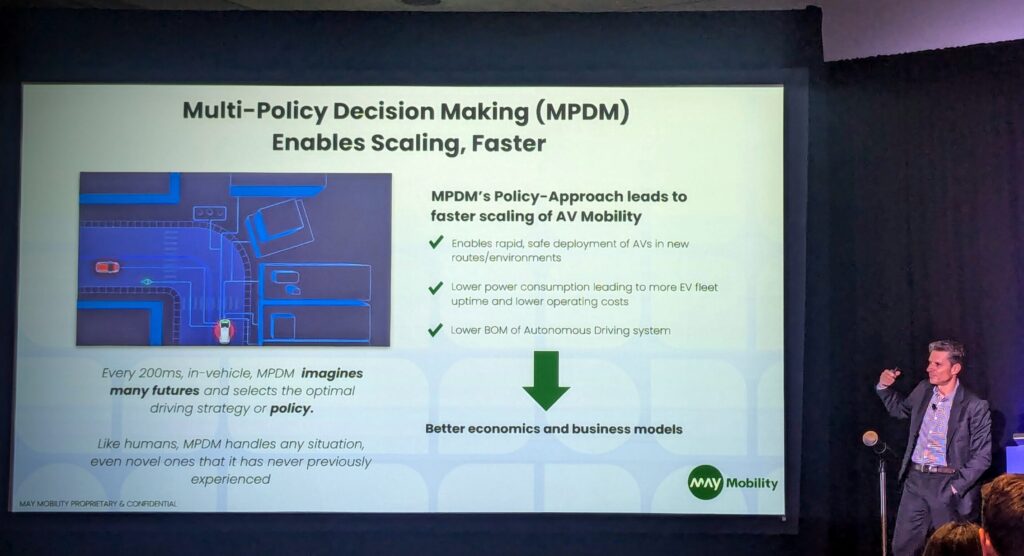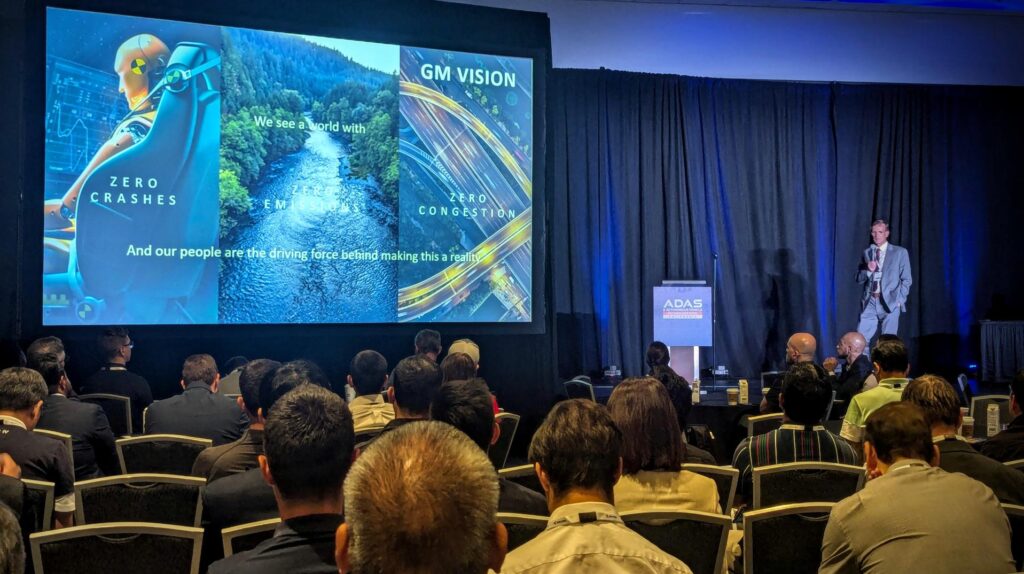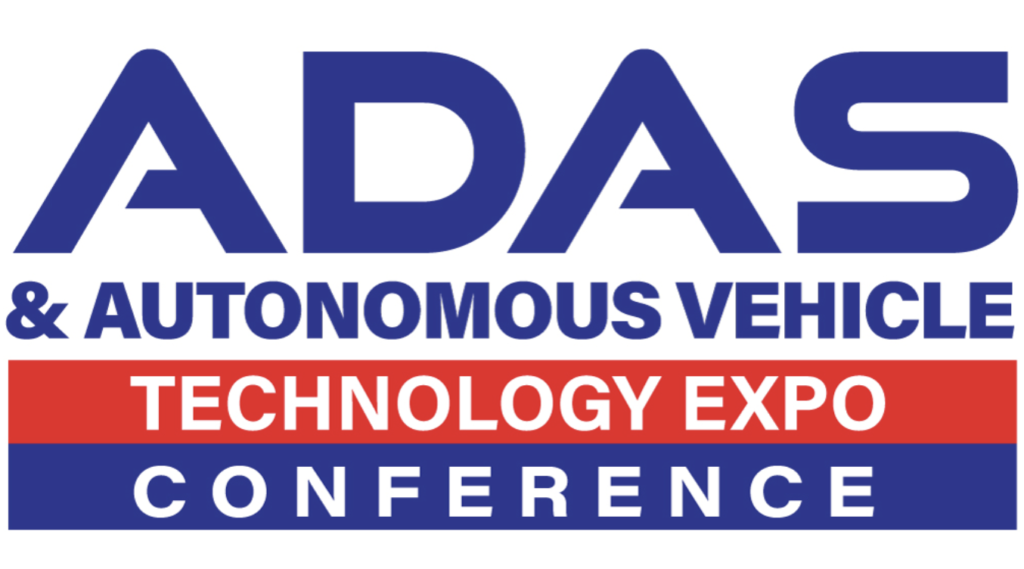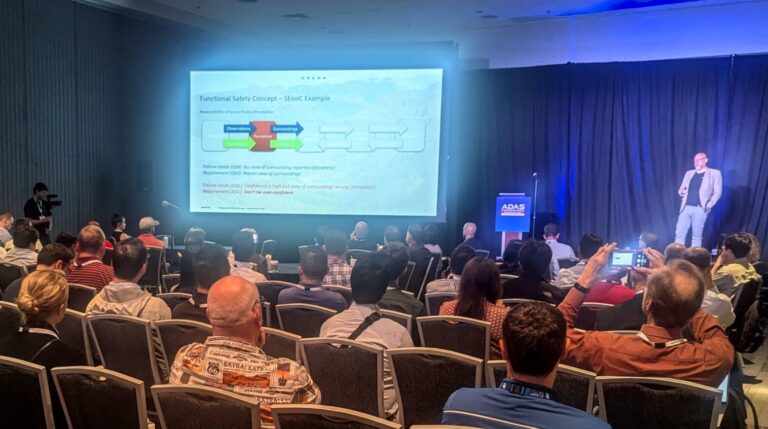ADAS & Autonomous Vehicle Technology Expo California is in full swing at the McEnery Convention Center in San Jose.
At the conference that runs alongside the expo (August 28 and 29), more than 50 speakers from international OEMs, Tier 1 suppliers, R&D centers and innovative transportation startups are sharing best practices and innovative strategies.
Over two days, conference delegates will hear about regulatory updates, challenges and innovations in AI and architecture, and key components in the test and development toolchain, as well as issues and strategies for safe AD/ADAS development and deployment.
May Mobility‘s Alessandro Norscia and General Motors‘ Curtis Hay were two of the highlights on the first morning of the conference.
May Mobility’s approach to scalability

Alessandro Norscia, vice president of product at May Mobility, spoke in the ‘Developing software, AI, big data and architecture – challenges and innovations’ session, with a presentation entitled, ‘Unlocking the future of autonomous vehicles: Scalability for next-gen mobility’.
Norscia talked to ADAS & Autonomous Vehicle International at the event and explained more about his presentation and how the company’s autonomous driving technology overcomes the complexities of AV scalability.
“Scalability is the key to unlocking the future of autonomous vehicles, such as achieving their widespread deployment. To make this a reality, we believe it is essential to have leading-edge autonomous driving technology specifically designed for scalability. Additionally, this must be integrated with a series of complementary systems, technologies, methodologies and procedures essential for the rapid deployment of AVs.
“First and foremost, May Mobility’s AD technology is exceptionally performant,” he continued. “While it fully utilizes the conventional method of pretraining AI models in a data center, our technology is unique in that it also generates training data and learns new driving behaviors in real time, while it’s driving. This allows our vehicles to safely adapt to new, complex and unpredictable driving conditions solving the ‘edge case’ aka ‘long tail’ challenge. As a result, we achieve shorter deployment times in new environments and improved economics – both of which are crucial for scalability.
“Secondly, there are a number of factors beyond core AI technology that are essential for safe operation on public roads and ensuring the economics of large-scale deployments. One key factor is a robust data analytics capability, enabling the extraction of critical insights from the vast amounts of data typically gathered by AVs. The other is end-to-end system design. This includes selecting the right vehicle, implementing remote supervision functions and providing tools and user interfaces that ensure riders feel comfortable and safe without an in-vehicle operator.
“Lastly, seamless, back-end integration with mobility service ecosystem partner companies is vital for success.”
Reflecting on the expo and his participation in the conference, Norscia said, “The expo represents a unique convergence of industry leaders, innovators and visionaries, all working toward a common goal – revolutionizing urban mobility through advanced technology. It’s an opportunity to share insights, explore cutting-edge developments and collaborate on solving the challenges that come with scaling autonomous driving solutions. As someone deeply involved in the product development side of autonomous vehicles, I’m excited to contribute to the discussion and learn from others who are pushing the boundaries of what’s possible in this space.”
General Motors on the role of inertial sensors for automated driving

Curtis Hay, technical fellow at General Motors, took part in the ‘Key issues, strategies and innovations and their implications for safe AD/ADAS development and deployment’ session on Day 1. In an interview with AAVI ahead of his presentation, Hay said he hoped his talk would show delegates that “automated vehicles require a thoughtful method to compute location – both in a relative and an absolute sense”. He explained that the IMU is often an overlooked component with automated vehicle localization and pointed out that with important IMU innovations on the horizon, OEMs have an opportunity to optimize the localization architecture to improve performance and reduce cost.
Speaking to AAVI after his presentation he said, “It’s a challenging and dynamic time within the global automotive industry. AI, electrification and advanced automation trends are all driving innovation and business investment in areas that weren’t even considered a few years ago. It’s increasingly important for OEMs to establish strategic partnerships that accelerate innovation in ways that delight our customers. GM strives to do this every day.”
You can read the full pre-show interview with Curtis here.
Find out more about the conference here


